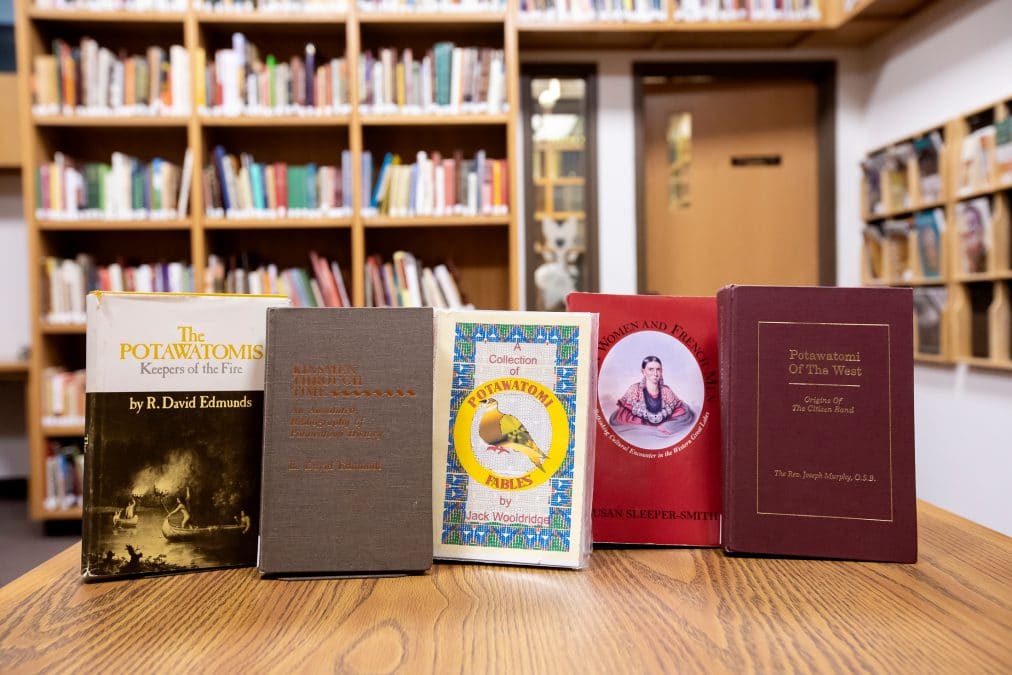Many Citizen Potawatomi Nation tribal members seek to learn more about their Native American heritage and family trees, and numerous on and offline resources exist to aid in the process.
As part of the CPN Cultural Heritage Center’s Collections and Research Division, the research center and library contains more than 7,000 pieces of mixed-media Tribal history and culture. However, due to the coronavirus pandemic, it is currently closed to visitors, but Family History Specialist Czarina Thompson is available to assist Tribal members virtually and via phone as they begin their genealogy journey.
“Hopefully, each place you go, even if you don’t get a cool piece of information, you may get a lead to go somewhere else and look. Because the best part of family research is the journey. It really is, I feel,” she said.

Knowing Potawatomi history
Thompson works in the CHC’s Collections and Research Division. She often describes Potawatomi family trees as more like a web. When people ask her how to begin piecing theirs together, she tells them to start with CPN history.
“That gives you a road to go back on and where to look,” Thompson said.
Given the Bodéwadmi people’s numerous forced removals and connections with communities across the United States from Great Lakes region to Oklahoma, connecting the dots comes down to knowing where to look on the Tribe’s historical timeline.
Sometimes a family member’s stories provide the most significant tie.
“I think there’s a place in everybody’s life to reach out to that great aunt who’s 100-and-something. Even if she doesn’t sound like she knows what she’s talking about, that’s OK. … She might tell you this wild and crazy story made out of three stories … But it will still give you that hint,” Thompson said.
Nishnabé people rely on oral traditions to pass things along to the next generation and revere elders as an essential part of the culture, including family histories. While working with Tribal members searching for answers, Thompson has often heard members express the same regret.
“This is one thing they always say: ‘I wish I had asked when they were still here.’ … We’re kind of so stuck in technology, and we don’t go visit our family, and we don’t have family gatherings like we used to,” Thompson said.
The holiday season provides time to sit down with elders and record their stories, preserving valuable resources for generations to come.
Along with family stories, there are many resources available to begin piecing together family history.
On and offline
The CHC hosts online collections of photographs and documents organized by Potawatomi family name. Some census documents are available as well as written histories, allotment information and portions of family trees. However, it contains a wide variety of amounts and types of details in each collection. Diving in and searching for connections is the best way to utilize this resource. Find more information at cpn.news/collections.
Thompson recommends ancestry.com as a promising starting point as well. The difficulty of finding accurate records means some online genealogy sites may not provide as many as hoped. However, Thompson said the site sometimes acts as a reliable secondary or even primary source.
“Within it, you can actually see censuses, Indian censuses. They have them, and they are for different years. And so you can almost pinpoint a possible year of death for an individual or a year of birth for an individual if you research other family members, a sibling of your ancestor’s information would relate to your ancestor as well,” she said.
Findagrave.com also stores information from across the United States. It comes in particularly handy for CPN members spread throughout the country with family histories rooted in different places. Users update the information on the site, so finding another source to back up the findings ensures its accuracy.
“Sometimes, you’ll find as much information at findagrave(.com) as you may on Ancestry(.com),” Thompson said. “So, there is sometimes more just besides the grave and the dates — obituaries, bios, also other family members, including spouses, children and parents.”
Historical society websites, including the Oklahoma Historical Society and Pottawatomie County Historical Society, house archives of many documents on land titles, probates and more. Researching holdings from these resources can also be a productive endeavor.
Libraries sometimes offer genealogy classes and access to Ancestry.com at no cost.
“They’ll help you. Librarians are your best friend in the world when it comes to research. They really are. They can get you there,” Thompson said.
She reminds everyone to keep an open mind regarding sources for family members’ names and information, such as newspaper obituaries and articles, and church directories.
Visit the CPN Cultural Heritage Center online at potawatomiheritage.com and the family collections from the Research and Archives division at cpn.news/collections. To fill out a research request form from the CHC, email Czarina Thompson at cthompson@potawatomi.org.
